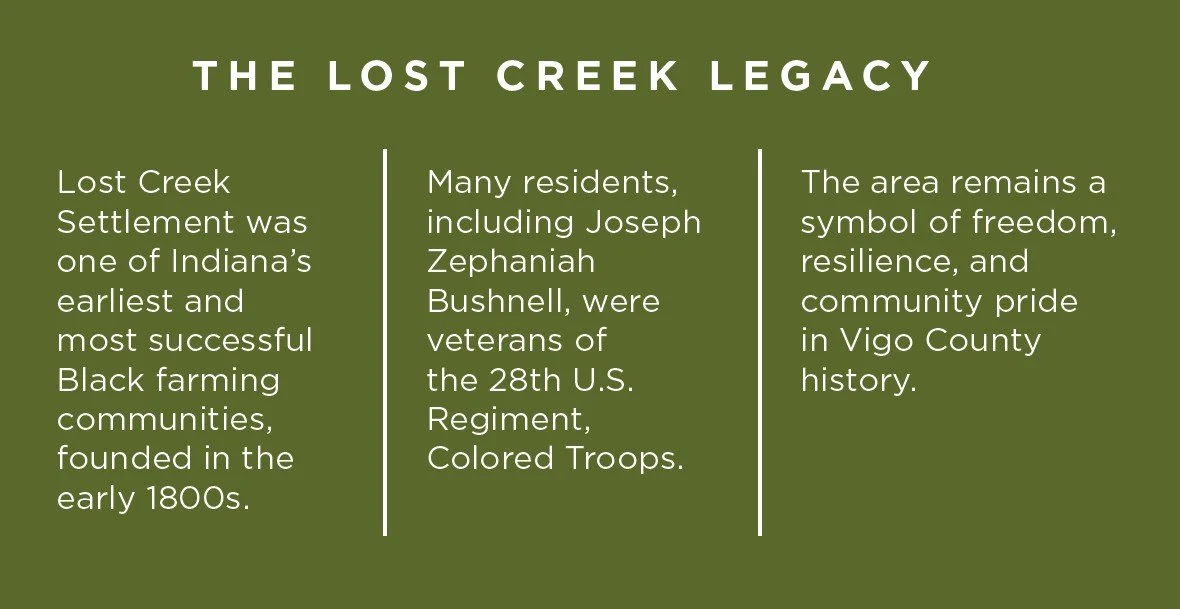Bushnell’s North Star Woods: Honoring Self-Determination, Legacy, and the Land
Ouabache Land Conservancy (OLC) took another meaningful step in its mission to preserve the natural landscapes of west central Indiana by protecting Bushnell’s North Star Woods, a property with rich ecological value and deep roots.
Located in the heart of the Lost Creek Settlement, the 124-acre woodland represents a haven for native wildlife and plants and a living connection to the courageous Black American families who built new lives in this region before and after the Civil War.
A Landscape of Heritage
The Bushnell family’s story is woven into the very soil of this property. Joseph Zephaniah Bushnell, born in 1833, was among the thirty-six Black men from Lost Creek Township who enlisted in the 28th Regiment, United States Colored Troops, joining the fight for freedom in 1865. Serving under Generals George Meade and Ulysses S. Grant, the regiment fought in the Battle of the Crater in Petersburg, Virginia, a defining moment of bravery where nearly half the regiment was killed or wounded.
After returning to Indiana, Joseph Bushnell purchased land in Lost Creek, which now forms part of OLC’s protected property. His legacy of courage, resilience, and determination continues through his descendants, including Michael Russell, who lives adjacent to the preserve and is a direct descendant of Joseph and his daughter Mary Bushnell Russell.
A 1926 photograph captures three generations of the family standing proudly near their home on Hunt Road—just steps away from today’s preserve entrance. That home still stands, a quiet sentinel to the area’s enduring heritage
Historical Timeline
Why “North Star”
The name Bushnell’s North Star Woods honors both the Bushnell family and the broader Black American journey toward freedom. The North Star guided countless self-liberated individuals along the Underground Railroad and became an enduring symbol of hope, immortalized in 1847 when Frederick Douglass named his abolitionist newspaper The North Star.
OLC joins a larger community effort led by Art Spaces, Inc. and the City of Terre Haute to celebrate the history of the Lost Creek Settlement. The property’s name helps connect OLC’s conservation mission to the preservation of local Black heritage.
In 2024, Terre Haute unveiled a Frederick Douglass monument at 7th Street and Wabash Avenue—honoring his many visits to the area and his impact on the region’s story of justice and equality. Bushnell’s North Star Woods stands as a natural counterpart to that monument: a quiet landscape where history, hope, and habitat converge.
Conservation with Purpose
Though not yet open to the public, Bushnell’s North Star Woods will serve as a community learning space, where ecological education meets cultural reflection. Early stewardship plans include invasive species management and guided walks exploring the natural diversity and the site’s historical significance.
The property includes a rustic shelter, which OLC envisions using for small group gatherings, outdoor classrooms, and community events. Adjacent to the shelter lies a new 16-space parking area with two accessible parking spaces.
A Signal for the Future
As OLC approaches 1,200 acres of protected land, Bushnell’s North Star Woods embodies the Conservancy’s continued commitment to not just protect land, but legacy. This project bridges the past and future, preserving open space while honoring those who once found their own “north star” in the Indiana sky.
A note from Dee Reed, a Terre Haute-based leader in communications, cultural inclusion, and heritage preservation and a descendant of the historic Lost Creek Settlement
The Lost Creek Settlement was established in the early 1800s, when a small group of free Black Americans courageously traveled from North Carolina to settle in eastern Vigo County to escape the racial violence and systemic oppression of the pre-Civil War South. In the South, free Blacks faced discrimination and legal barriers that restricted their rights, including laws that restricted their ability to read, write, vote, serve in the military, and gather for religious services.
These pioneers purchased thousands of acres of property, creating a successful farming community for generations. According to the Indiana Historical Society, the Lost Creek Settlement maintained the largest number of Black farmers in the state.
The Lost Creek African Methodist Episcopal (A.M.E.) Church, built in 1840, was part of the Underground Railroad network, which was led by the Friends or Quakers. It is reported that the refugees had a secret meeting place in a hollow on the north side of Hawthorne Avenue. From there, it is believed they journeyed to the Markle House in Otter Creek and onward north to a station in Rockville, Indiana.
The settlement became a thriving community - a hub of the economic, social, spiritual, and intellectual lives of its residents. The settlers were autonomous and progressive. They established their own schools, churches, businesses and social organizations. This community overcame various forms of marginalization and left a legacy of faith, perseverance, and service, which lives on in the lives of their descendants, who have shaped the community and culture in innumerable ways.
ART INSTALLATION
OLC supports Art Spaces, Inc. and the City of Terre Haute in the public recognition of the history of the Lost Creek Settlement with an art installation located in Deming Park. This compelling art installation titled, “A View from the Porch,” honors the contributions of these residents who help to shape the Terre Haute community and culture in innumerable ways.
Sources
https://lost-creek.org/genealogy/index.php
https://lost-creek.org/genealogy/getperson.php?personID=I1142&tree=tree2
https://www.in.gov/iwm/battle-flag-collection/28th-regiment,-united-states-colored-troops/

